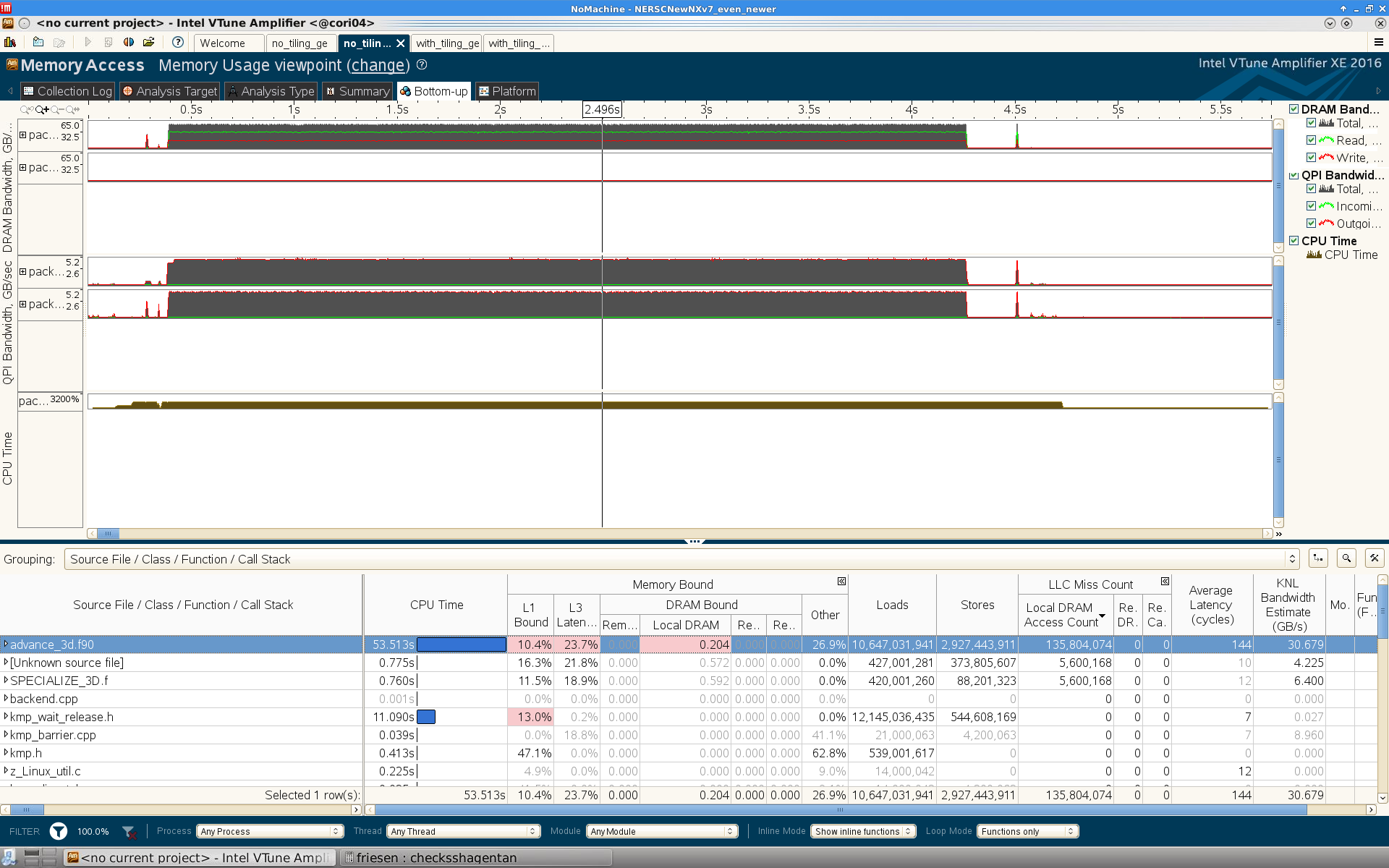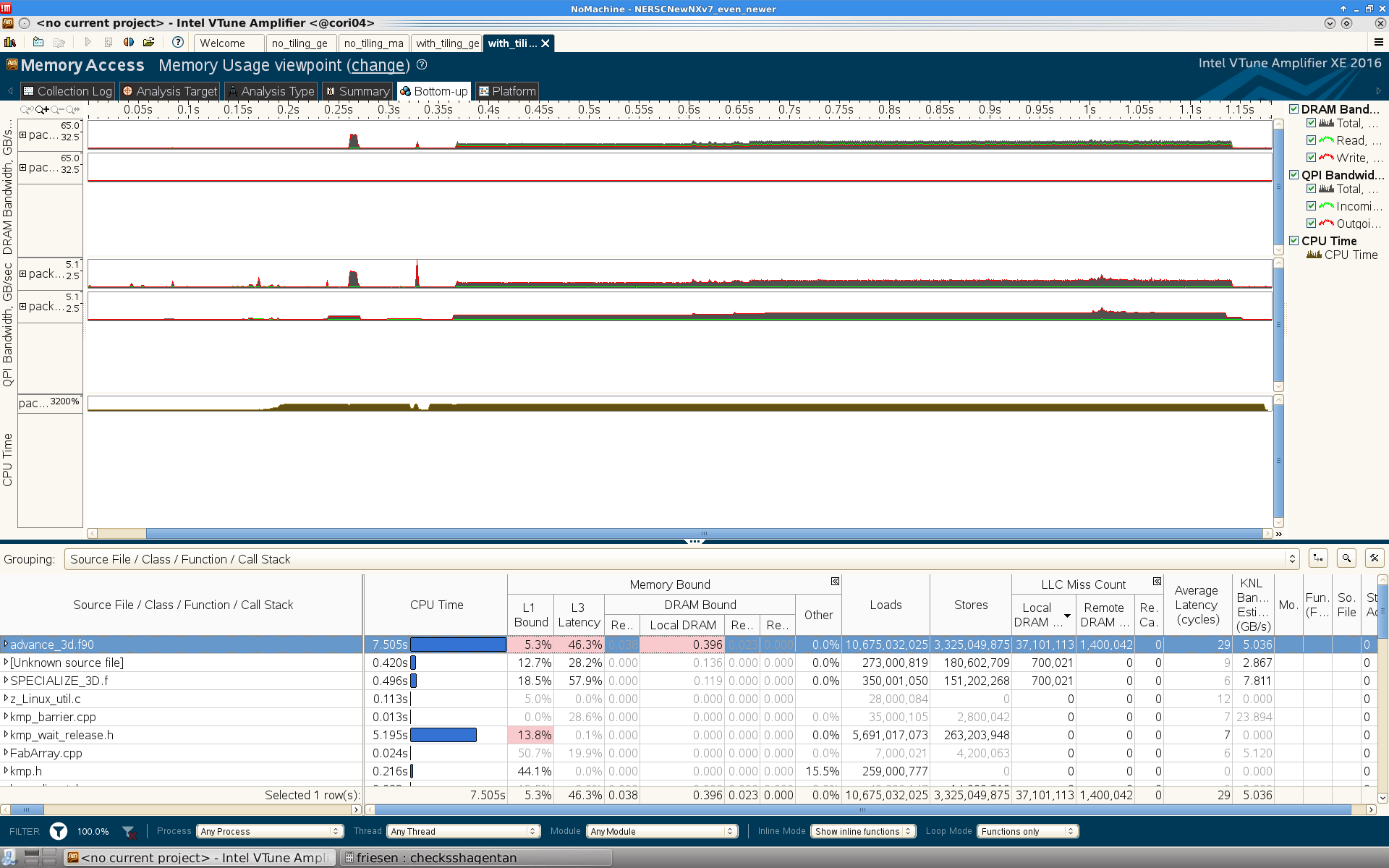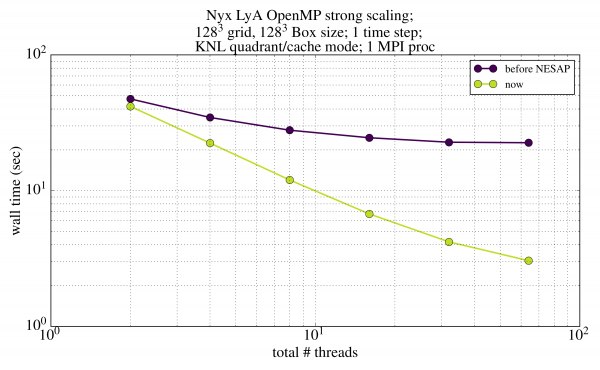AMReX¶
Background¶
AMReX is a software framework for the development and implementation of massively parallel algorithms using block-structured adaptive mesh refinement (AMR). Block-structured AMR provides the basis for the temporal and spatial discretization strategy for a large variety of applications of interest to the DOE. AMReX provides a unified infrastructure with the functionality needed for applications to be able to effectively and efficiently utilize machines from laptops to exascale accelerator-based architectures. AMR reduces the computational cost and memory footprint compared to a uniform mesh while preserving accurate descriptions of different physical processes in complex multi-physics algorithms. AMReX supports algorithms that solve systems of partial differential equations (PDEs) in simple or complex geometries, and those that use particles and/or particle-mesh operations to represent component physical processes.
Key features of AMReX include:
- Support for block-structured AMR with optional subcycling in time
- Support for cell-centered, face-centered and node-centered data
- Support for hyperbolic, parabolic, and elliptic solves on hierarchical grid structure
- Support for hybrid parallelism model with MPI and OpenMP
- Support for particles, collisions and particle-mesh operations.
- Support for embedded boundary based on the cut-cell methodology
- Support for GPU systems through AMReX's portability layer.
- Basis of mature applications in combustion, astrophysics, cosmology, accelerator physics, multiphase modeling, wind modeling and porous media
- Demonstrated successful scaling on all major DOE supercomputers and several other
- Source code freely available
We have approached the problem of optimization for manycore architectures from several different perspectives. Listed below are a few such efforts.
Loop tiling with OpenMP¶
In most AMReX codes, the majority of the computational expense lies in either "vertical" (point-wise) evaluations, e.g.,
do k = lo(3), hi(3)
do j = lo(2), hi(2)
do i = lo(1), hi(1)
phi_new(i, j, k) = phi_old(i, j, k) + &
dt * (flux_x(i, j, k) + flux_y(i, j, k) + flux_z(i, j, k))
end do
end do
end do
or "horizontal" (stencil) evaluations:
do k = lo(3), hi(3)
do j = lo(2), hi(2)
do i = lo(1), hi(1)
val(i, j, k) = (p_old(i-1, j, k) - p_old(i+1, j, k)) + &
(p_old(i, j-1, k) - p_old(i, j+1, k)) + &
(p_old(i, j, k-1) - p_old(i, j, k+1))
end do
end do
end do
where lo and hi represent the lower and upper coordinates of the computational grid. To parallelize this calculation, AMReX divides the domain into smaller "Boxes" and distributes these Boxes across MPI processes. Each MPI process then iterates through each Box that it "owns," applying the same operator to each Box and exchanging ghost cells between Boxes as necessary. Within a Box, lo and hi represent the lower and upper coordinates of the Box, not the entire domain.
Traditionally, iterating over distributed data sets contained in Boxes has been the task of flat MPI code. However, emerging HPC architectures require more explicit on-node parallelism, for example using threads via OpenMP, in order to use the machine resources effectively. There are several possible ways to express on-node parallelism in AMReX with OpenMP:
-
Thread over Boxes, with each entire Box being assigned to a thread. This is straightforward to implement and is noninvasive to the existing code base. However it is highly susceptible to load imbalance, e.g., if an MPI process owns 5 boxes but has 8 threads, 3 of those threads will be idle. This kind of imbalance occurs frequently in AMR simulations, so we did not pursue this option.
-
Thread within each Box. Rather than assign an entire Box to a thread, we stripe the data within each Box among different threads. This approach is less susceptible to load imbalance than option #1. However, it requires spawning and collapsing teams of threads each time an MPI process iterates over a new Box, which can lead to significant overhead. For example, updating the 3-D heat equation at a new time step might look like:
!$omp parallel private (i, j, k)
!$omp do collapse(2)
do k = lo(3), hi(3)
do j = lo(2), hi(2)
do i = lo(1), hi(1)
f_x(i, j, k) = (p_old(i-1, j, k) - p_old(i, j, k)) * dx_inv
end do
end do
end do
!$omp do collapse(2)
do k = lo(3), hi(3)
do j = lo(2), hi(2)
do i = lo(1), hi(1)
f_y(i, j, k) = (p_old(i, j-1, k) - p_old(i, j, k)) * dx_inv
end do
end do
end do
!$omp do collapse(2)
do k = lo(3), hi(3)
do j = lo(2), hi(2)
do i = lo(1), hi(1)
f_z(i, j, k) = (p_old(i, j, k-1) - p_old(i, j, k)) * dx_inv
end do
end do
end do
!$omp end parallel
- Tile the iteration space over all Boxes owned by a process. Rather than a group of threads operating on each Box, divide each Box owned by a given MPI process into smaller tiles, and assign a complete tile to a single thread. For example, if an MPI process owns 2 Boxes, each of size 643, and if we use tiles which are of size 64x4x4, then each Box yields 256 tiles, and that process will operate on a pool of 256x2 = 512 tiles in total. If each MPI process can spawn 16 threads, then each thread works on 32 tiles.
Code featuring loop tiling in AMReX would look something like the following:
!$omp parallel private(i,mfi,tilebox,tlo,thi,pp_old,pp_new,lo,hi)
call mfiter_build(mfi, phi_old, tiling= .true., tilesize= tsize)
do while(next_tile(mfi,i))
tilebox = get_tilebox(mfi)
tlo = lwb(tilebox)
thi = upb(tilebox)
pp_old => dataptr(phi_old,i)
pp_new => dataptr(phi_new,i)
lo = lwb(get_box(phi_old,i))
hi = upb(get_box(phi_old,i))
call advance_phi(pp_old(:,:,:,1), pp_new(:,:,:,1), &
ng_p, lo, hi, dx, dt, tlo, thi)
end do
!$omp end parallel
subroutine advance_phi(phi_old, phi_new, ng_p, glo, ghi, dx, dt, tlo, thi)
! variable declarations ...
do k = tlo(3), thi(3)
do j = tlo(2), thi(2)
do i = tlo(1), thi(1)
phi_new(i, j, k) = phi_old(i, j, k) + dt * (flux_x + flux_y + flux_z)
end do
end do
end do
end subroutine do work
We tested outer-loop-level threading as well as tiling in AMReX codes and found the latter to be significantly faster, especially for large numbers of threads. As an example, we implemented the threading strategies discussed in options #2 and #3 above in a simple 3-D heat equation solver with explicit time-stepping in AMReX. The domain was a 1283 grid spanned by a single Box (for flat MPI codes we would generally use smaller and more numerous Boxes, typically of size 323). We then ran the heat solver for 1000 time steps using a single MPI task with 16 threads spanning one 16-core Haswell CPU on a dual-socket system node.
Before analyzing the code with VTune, we executed both threaded codes 5 times consecutively and measured the wall time for each run. (OS noise and other "ambient" factors in a computational system may cause a single run of a threaded code may run abnormally quickly or slowly; a statistical sample of run times is therefore crucial for obtaining a reliable timing measurement.) The timings reported were as follows:
| Iteration # | Outer-loop-level threading | Loop tiling |
|---|---|---|
| 1 | 3.76 | 0.58 |
| 2 | 3.87 | 0.69 |
| 3 | 3.86 | 0.70 |
| 4 | 3.86 | 0.69 |
| 5 | 3.84 | 0.68 |
We see that in all 5 iterations, the tiled code ran about 5.6x faster than the outer-loop-level threaded code. Now we turn to VTune to find out exactly what lead to such an enormous speedup. We will focus first on the outer-loop-level threaded code, and next on the tiled code.
Outer-loop-level threading: General exploration¶
We first turn to the "general exploration" analysis, which provides a high-level overview of the code's characteristics (open the image in a new window to view in full size):

We see that the code is almost entirely (93%) back-end bound. This is typical for HPC codes using compiled languages (as opposed to JIT codes). Within the "back end", we see further that 78% of the code instructions are memory bound, and only 15% core bound. This is typical of stencil-based codes. Since memory access seems to be the bottleneck in this code, we can run a "memory access" analysis within VTune to find more information about how exactly the code accesses data in memory.
Outer-loop-level threading: Memory access¶
Below is shown the summary page from the memory access analysis in VTune:

We see first that the "elapsed time" according to this analysis is significantly higher than both the raw wall clock time we measured ourselves (see the above table) and the wall time according to the general exploration analysis. It is likely that VTune's detailed sampling and tracing interfere with its wall clock measurements. This is not a problem for us since we are much more interested in VTune's sampling and tracing data than in its wall clock measurements.
The summary page shows that a large fraction of memory loads come all the way from DRAM, as opposed to cache. The latency to access DRAM is slow, so we want to minimize this as much as possible. In particular, the bottom-up view (see figure below) shows that in the advance_3d routine (which comprises the bulk of the code's run time), every micro-operation instruction stalls for an average of 144 CPU cycles while it waits for the memory controller to fetch data from DRAM. This highlights the fundamental flaw of outer-loop-level threading in our heat equation solver: it makes extremely poor use of local caches; only about 1/3 of the code is bound by latency to access L1 (private) or L3 (shared) cache, while most of the remainder is spent waiting for DRAM accesses.
The reason that DRAM latency is the fundamental bottleneck of this code is because the 3-D heat stencil loads data from non-contiguous locations in memory, i.e., it reads elements i and i-1, as well as j and j-1 and k and k-1. When we collapse the loop iteration space, each thread will load element i and several of its neighbors (e.g., i-2, i-1, i+1, i+2) in a single cache line, since the data are contiguous along the x-direction. However, the j and j-1 and k and k-1 elements will likely not be located in the same cache line as well (unless the total problem domain is extremely small). So every evaluation of elements j-1 and k-1 requires loading a new cache line from DRAM. This leads to extremely large DRAM bandwidth and, more importantly, the huge latency we see in the memory access analysis. We can see the huge bandwidth usage in the "bottom-up" view:

The memory bandwidth throughout the code execution is about 56 GB/sec, which is nearly the limit for the entire socket. This is due to the frequent cache line loads to access non-contiguous data elements for the heat stencil evaluation, as discussed earlier.
We now turn to the tiled code to explore how it solves these problems.
Tiling: General exploration¶
Shown below is the summary page in the general exploration analysis of the tiled code:

As with the outer-loop-level threaded code, the tiled code is still primarily back-end bound, although this component is reduced from 93% to 76%. Interesting, within the "back end," whereas the previous code was almost entirely memory bound, the tiled code is split between being core-bound and memory-bound. This indicates that we have relieved much of the pressure that the previous code placed on the memory controller, presumably by requesting fewer accesses to DRAM. We turn to the memory access analysis for more details.
Tiling: Memory access¶
The summary page of the memory access analysis of the tiled code is as follows:

From this analysis we see that the the L1 cache usage is roughly the same as with the previous code. The L3 cache behavior is somewhat improved. However, the crucial difference is that the number of DRAM accesses has been reduced by a factor of almost 4. This in turn has reduced the average latency per instruction in the advance_3d routine from 144 cycles in the previous example to just 29 in the tiled code.
The bottom-up view sheds additional light on the memory access patterns of the tiled code:

As expected, the DRAM bandwidth is much lower, averaging around 10 GB/sec. This is because far fewer cache lines need to be loaded to evaluate each stencil in the tiled iteration space.
We see now that the overwhelming benefit of loop tiling over outer-loop-level threading is the reduction in memory bandwidth and latency by reducing accesses to DRAM. The reason for this reduction is that each tile of the iteration space contains nearby neighbors in all 3 directions from point (i, j, k). So each load of elements j-1 and k-1 is likely now to come from a layer of cache, rather than all the way from DRAM.
We emphasize that the tiling technique is most useful for horizontal (stencil) calculations, in that it gathers non-contiguous data elements into cache. For vertical (point-wise) calculations which depend only on point (i, j, k) and not on any of its neighbors, tiling has little effect on performance. For these types of calculations, vectorization is a much more fruitful endeavor.
Vectorization of compressible gasdynamics algorithms¶
AMReX-powered codes spend the majority of their execution time applying a series of operators to a hierarchy of structured Cartesian grids. Such operators generally take one of two forms: "horizontal" operations on several neighboring grid points to produce a result at a single point (e.g., stencils); and "vertical" or "point-wise" operators, which require only data at a single grid point in order to produce a new result at that point (e.g., reaction networks, equations of state, etc.). As we have seen above, horizontal operators benefit significantly from loop tiling, because it gathers neighboring points of grids (which are non-contiguous in memory) into cache, requiring fewer DRAM accesses during each grid point update. However, vertical operators see less benefit from loop tiling, because they do not require access to data at neighboring points.
The performance of point-wise operators is of critical importance in compressible gasdynamics codes such as Nyx and Castro. The reason for this is that these two codes use computationally expensive advection schemes (based on the piecewise-parabolic method, or "PPM"), and Nyx also uses an exact Riemann solver, which far more expensive than the approximate Riemann solvers used in many other gasdynamics codes. In fact, the PPM and Riemann solver are the two most expensive kernels in the entire Nyx code; we can see this in VTune using its "general exploration" feature, shown below:

We see in the "bottom-up" view that the routines analriem and riemannus (both components of the analytic Riemann solver), and ppm_type1 are the hottest kernels in the code, and together comprise 1/3 of the total instructions retired, as well as more than 1/3 of the entire code run time. All of these routines contain point-wise operations on each (x, y, z) grid point on the problem domain. We see that the routine analriem is heavily L1 cache-bound, makes frequent use of divider instructions, and also rarely exploits more than 1 of the 8 available execution ports on the Haswell processor. (A description of the different execution ports is provided in Chapter 2 of the Intel 64 and IA-32 Architectures Optimization Reference Manual. See also this Intel page for a description of the functions mapped to each port.) All of these characteristics indicate that the Riemann solver is making poor use of vector instructions, and also that its performance would increase significantly via loop vectorization.
Now that we have confirmed that a lack of vectorization is the cause of this code bottleneck, we can turn to the code itself to see what options are available to remedy this problem. The pseudo-code for the Riemann solver in Nyx takes the following form:
subroutine riemannus()
! declare lots of scalar temporary variables to save temporary values for
! each complete iteration of the i loop
do k = klo, khi
do j = jlo, jhi
do i = ilo, ihi
! calculate left and right gas velocities
! lots of sanity checks for gas pressure and internal energy
! lots of if/then/else's to make sure we use sane values
call analriem(gas_velocities, misc_gas_data) ! returns new pressure and velocity from analytic Riemann solver
! lots of post-processing if/then/else's
! calculate shock velocity
! calculate fluxes
end do
end do
end do
end subroutine riemannus
This loop is hundreds of line long, and contains a great deal of branching due to if/then/else's which are used to ensure the Riemann solver uses physically consistent values. The analriem routine is also complicated, although it is smaller than riemannus:
subroutine analriem(gas_velocities, misc_gas_data)
! set up lots of auxiliary variables derived from gas velocity, pressure, etc.
do i = 1, 3,
! iterate on the new values of pressure and density 3 times to ensure they've converged
end do
end subroutine analriem
As a result of this code complexity, compilers are unable to vectorize any layer of the outer (i, j, k) loop in riemannus, even though the Riemann solver does not require values from any grid points other than (i, j, k) itself. The entire Riemann solver, then, is executed serially, leading to a severe bottleneck in the overall execution of the Nyx code. Additionally, even if a compiler was smart enough to generate vectorized versions of this loop, the heavy use of if/then/else inside the loop would inhibit performance due to a high degree of branch mispredicts. Furthermore, many compilers are extremely cautious or unwilling entirely to vectorize function calls inside loops, such as the call to analriem inside the loop in riemannus.
One way to vectorize the outer loop of the Riemann solver is to use the omp simd directive introduced in OpenMP 4.0. However, this approach generates vector instructions only if we compile the code with OpenMP support; if instead we use pure MPI or another framework to express intra-node parallelism, the compiler ignores the omp directives and the generated instructions will remain serial. A more portable solution is to write the loops in such a way that compilers' static analysis can easily detect that the loops have no dependencies and are vectorizable. In the case of this Riemann solver, we can combine the introduction of some temporary arrays with loop fissioning techniques to generate a series of much simpler loops. We caution that, although we have had great success with these techniques, they can result is more obfuscated code which, although easy for a compiler to analyze, may be more difficult for a (human) developer to interpret.
The pseudo-code for the vectorized version of the Riemann solver looks like the following:
subroutine riemannus()
! replace scalar temporary variables which are overwritten after each
! iteration of the i loop with arrays which save temporary values for all
! values of (i, j, k)
do k = klo, khi
do j = jlo, jhi
do i = ilo, ihi
! calculate left and right gas velocities
end do
end do
end do
do k = klo, khi
do j = jlo, jhi
do i = ilo, ihi
! lots of sanity checks for gas pressure and internal energy
! lots of if/then/else's to make sure we use sane values
end do
end do
end do
call analriem(gas_velocities, misc_gas_data) ! returns new pressure and velocity from analytic Riemann solver
do k = klo, khi
do j = jlo, jhi
do i = ilo, ihi
! lots of post-processing if/then/else's
end do
end do
end do
do k = klo, khi
do j = jlo, jhi
do i = ilo, ihi
! calculate shock velocity
! calculate fluxes
end do
end do
end do
end subroutine riemannus
We have replaced the scalar temporary variables in riemannus with arrays of temporaries which endure throughout the multiple (i, j, k) loops in riemannus. This increases the memory footprint of the algorithm, but also yields shorter loops which are easier for compilers to vectorize. We note that, if the compiler generates purely scalar instructions for these refactored loops, the overall execution time will be the same as the original loop, although the memory footprint will still be larger. However, since we have had success with several different compilers vectorizing these loops, the performance of riemannus has increased significantly. We note a few features of these new, shorter loops:
Some loops still do not easily vectorize, or if they do, their vector performance is not much faster than the original scalar code. These loops are chiefly the ones which contain all the if/else logic. Happily, these are not particularly expensive loops, and so it does not hurt performance a great deal if they remain scalar. The loop which we do want to vectorize is analriem, which is no longer called inside an (i,j,k) loop, but rather has absorbed the loop inside itself:
subroutine analriem(gas_velocities, misc_gas_data)
do k = klo, khi
do j = jlo, jhi
do i = ilo, ihi
! set up lots of auxiliary variables derived from gas velocity, pressure, etc.
do ii = 1, 3,
! iterate on the new values of pressure and density 3 times to ensure they've converged
end do
end do
end do
end do
end subroutine analriem
In this form, compilers are much more willing to vectorize the analytic Riemann solver (and unroll the small innermost loop as well), since it is no longer called inside an outer (i, j, k) loop.
We applied similar loop fissioning techniques to the PPM advection algorithm. The original pseudo-code had the following form:
subroutine ppm_type1()
! x-direction
do k = klo, khi
do j = jlo, jhi
do i = ilo, ihi
! lots of if/else to calculate temporary variables
! use temporary value to calculate characteristic wave speeds
end do
end do
end do
! similar triply-nested loops for y- and z-directions
end subroutine ppm_type1
After replacing several temporary scalar variables with temporary arrays, we were able to fission these loops as follows:
subroutine ppm_type1()
! x-direction
do k = klo, khi
do j = jlo, jhi
do i = ilo, ihi
! lots of if/else to calculate temporary variables
end do
end do
end do
do k = klo, khi
do j = jlo, jhi
do i = ilo, ihi
! use temporary value to calculate characteristic wave speeds
end do
end do
end do
! similar triply-nested loops for y- and z-directions
end subroutine ppm_type1
The first of these new, shorter loops absorbs all of the myriad boolean logic encountered in the PPM algorithm, and although several compilers do vectorize it, its performance suffers from masking and branch mispredicts. The second short loop, however, has no logic, and it generates highly vectorizable code.
The results of these loop fissioning techniques is a significant increase in performance of the entire code. We can see the effects in both Intel VTune and in Intel Advisor. Starting with VTune, we see that the memory-bound portions of the code (and especially the L1 cache-bound portions) have been reduced by almost 10%. In addition, the code has become almost 10% more core-bound, which indicates that these changes have moved the Nyx code higher toward the roofline performance of the Haswell architecture on Cori Phase 1.
Turning to the "bottom-up" view in VTune, we see that, whereas the original Riemann solver was 62% L1 cache-bound, the new solver is only 22% bound. Also, the number of cycles with multiple ports used has increased significantly in the vector code, indicating that the vector instructions are making more efficient use of all of the execution ports available on Haswell.

Intel Advisor shows similar results to the VTune data. The vector efficiency of many of the newly fissioned loops in the PPM and Riemann solver routines is nearly optimal, although a few do suffer (not surprisingly, the ones which absorbed all of the complex boolean logic).
Because the Nyx and Castro codes use nearly identical advection schemes and Riemann solvers, porting these changes to Castro will be straightforward, and should yield a similar performance boost. We anticipate that the performance of the vectorized version of this code will increase even further on Knights Landing since it has even wider vector units than Haswell.
Vectorization of ODE integration in each cell¶
When simulating problems with radiation in Nyx, the most expensive kernel in the code is the one which integrates an ordinary differential equation (ODE) in each cell, which computes the effects of the radiation over the course of the time step being taken. This ODE is sensitive to the state of the cell - density, temperature, etc. - and can exhibit sharp, nearly discontinuous behavior when crossing certain physical thresholds. Consequently, one must integrate the ODE with an explicit method using many narrow time steps to resolve the sudden changes, or with an implicit method, which can take larger time steps. Nyx uses the latter approach, specifically using the CVODE solver from the SUNDIALS software suite.
This integration is expensive to compute because it requires several evaluations of the right-hand side (RHS) of the ODE; each evaluation of the RHS requires solving a non-linear equation via Newton-Raphson; and each Newton-Raphson iteration requires evaluating multiple transcendental functions, which are highly latency-bound operations. Each of these ODE integrations is done per cell, and in its original form in Nyx, this was an entirely scalar evaluation, leading to poor performance, especially compared with older Xeon processors which exhibit shorter latency for these types of function evaluations.
To improve the performance of this kernel, we rewrote this integration step such that CVODE treated multiple cells as part of a single system of ODEs. Typically implicit solvers such as CVODE require computing a Jacobian matrix of the ODE system during the integration; however, because these cells are in this case independent, the Jacobian matrix is diagonal. This allows us to use a diagonal solver for the Jacobian matrix, resulting in far fewer RHS evaluations than would be required if the Jacobian matrix was full. Finally, by grouping cells together as a single system, we rewrote the RHS evaluation as a SIMD function, computing the RHS for all cells in the system simultaneously.
SIMD evaluation of multiple Newton-Raphsons is challenging due to the differing number of iterations which are required to converge in the RHS evaluation in each cell. To address this, we require that, within a group of cells, the Newton-Raphson iterations for their RHSs continues until all cells achieve an error which is within the specified tolerance. This generally results in a few cells within the group iterating more than the minimum number of times required for convergence, which they wait for the slowest-converging cell to converge. However, while they may perform some unnecessary work, the overall speedup due to SIMD evaluation of the transcendental functions more than compensates for the extra work, and the result is significantly faster code, on both Xeon and Xeon Phi.
AMReX code performance on Intel Xeon Phi¶
In the figure below is a high-level summary of the performance improvement of vectorization and tiling on Nyx, a hybrid compressible gasdynamics/N-body code for cosmological simulations, which is based on the AMReX framework. The code was run on a pre-production version of the Intel Xeon Phi CPU 7210 ("Knights Landing"), which has 64 cores running at 1.30 GHz. The node was configured in "quadrant" mode (a single NUMA domain for the entire socket) and with the high-bandwidth memory in "cache" mode. The problem was a 128^3 domain spanned by a single 128^3 Box. We used a single MPI process and strong scaled from 1 to 64 OpenMP threads, using a single hardware thread per core (our codes see relatively little benefit from using multiple threads per core on Xeon Phi). We see that when we use all 64 cores, Nyx runs nearly an order of magnitude faster now than it did prior to the start of the NESAP program.

Tuning geometric multigrid solvers¶
One of the major challenges in applied mathematics for HPC is the scalability of linear solvers. This challenge affects many AMReX codes, since they encounter a variety of elliptic problems which must be solved at each time step. AMReX itself provides two elliptic solvers (one in C++, the other in Fortran), both of which use geometric multigrid methods.
In order to evaluate the performance of various algorithmic choices made in the two AMReX multigrid solvers, we recently ported the emergent geometric multigrid benchmark code HPGMG to AMReX. HPGMG provides compile-time parameters for choosing many different algorithms for the different steps of the multigrid method, including
- cycle types (pure F-cycles, pure V-cycles, or one F-cycle followed by V-cycles)
- smoothers (Gauss-Seidel red-black, Chebyshev, Jacobi, etc.)
- successive over-relaxation (SOR) parameters
- Helmholtz/Poisson operator discretizations (7-point and 27-point cell-centered; 2nd-order and 4th-order finite-volume; constant- or variable-coefficient)
- prolongation operators (piecewise-constant, piecewise-linear, piecewise-parabolic, 2nd-order and 4th-order finite-volume)
- bottom solvers (conjugate-gradient, BiCGSTAB, etc.)
- box agglomeration strategies during the restriction phase
By comparing these different algorithms with those in the AMReX multigrid solvers, we are able to see which are the most performant for the various types of elliptic problems encountered in AMReX codes. The results of this study are forthcoming.
In situ and in-transit data analysis¶
Although the majority of application readiness efforts for manycore architectures are focused on floating-point performance, node-level parallelism, and tireless pursuit of the roofline, data-centric challenges in HPC are emerging as well. In particular, simulations with AMReX codes can generate terabytes to petabytes of data in a single run, rendering parameter studies unfeasible. One may address this problem in several ways:
-
Assume that the generation of huge data sets is unavoidable. The problem then becomes one first of storage, and second of making sense of the data after the simulation is complete. This is the charge of data analytics.
-
Preempt the generation of huge data sets by performing the data analysis (and hopefully reduction) while the simulation is running.
We have focused on the 2nd approach. This option is sensible if one knows beforehand which features of the simulation data set are "interesting." Such a luxury is not always the case; exploratory calculations are a critical component of simulations, and in those cases this option is not useful. However, many data stewardship problems arise during parameter studies, where the same simulation is run with varying sets of parameters.
This type of on-the-fly data post-processing can be implemented in two different ways:
-
In situ: All compute processes pause the simulation and execute post-processing tasks on the data that they own.
-
In-transit: A separate partition of processes is tasked purely with performing post-processing, while the remaining processes continue with the simulation. This is a heterogeneous workflow and is therefore more complicated to implement, as well as more complicated optimize.
We recently implemented both of these data post-processing techniques in Nyx, a compressible gasdynamics/N-body code for cosmology based on the AMReX framework. Specifically, we focused on two sets of commonly used post-processing algorithms:
-
Finding dark matter "halos" by calculating topological merge trees based on level sets of the density field.
-
Calculating probability distribution functions (PDFs) and power spectra of various state variables.
The results of this work are published in the open-access journal Computational Astrophysics and Cosmology.